

Earth is getting a black box to record our climate change actions, and it's already started listening. On a granite-strewn plain, surrounded by gnarled mountains, sits a giant steel box.
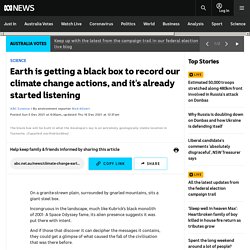
Incongruous in the landscape, much like Kubrick's black monolith of 2001: A Space Odyssey fame, its alien presence suggests it was put there with intent. And if those that discover it can decipher the messages it contains, they could get a glimpse of what caused the fall of the civilisation that was there before. This is Earth's Black Box. 'First and foremost, it's a tool' When an aeroplane crashes, it's left to investigators to sift through the wreckage to recover the black box.
It's hoped the recorded contents can be used to help others avoid the same fate. And so it is with Earth's Black Box: a 10-metre-by-4-metre-by-3-metre steel monolith that's about to be built on a remote outcrop on Tasmania's west coast. If that sounds unhinged, it's worth remembering that we're currently on track for as much as 2.7C of warming this century. Dead white man's clothes: How fast fashion is turning parts of Ghana into toxic landfill. Sea of Marmara algal bloom, dubbed 'sea snot', alarming Turkish scientists and fishermen. A thick, brown, bubbly foam dubbed "sea snot" has covered the shores of the Sea of Marmara, alarming Istanbul residents and threatening marine life.
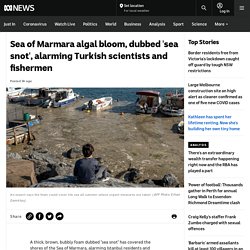
Key points: UN warns nature is in dangerous decline. L’Anthropocène. Anthropocene. ANTHROPOCENE ? The Anthropocene. Anthropocene. Worried about Earth's future? Well, the outlook is worse than even scientists can grasp. Anyone with even a passing interest in the global environment knows all is not well.
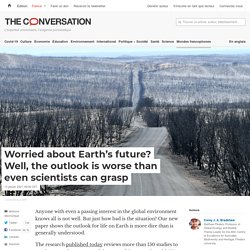
But just how bad is the situation? Our new paper shows the outlook for life on Earth is more dire than is generally understood. The research published today reviews more than 150 studies to produce a stark summary of the state of the natural world. We outline the likely future trends in biodiversity decline, mass extinction, climate disruption and planetary toxification. A New Chart of History. Welcome to the Anthropocene. Human Worlds of the Anthropocene. The effects of humans on the global environment are perceived to be so significant by some scientists that they argue humans have become a major driving force in environmental change on a par with the forces of nature.
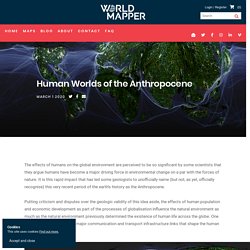
It is this rapid impact that has led some geologists to unofficially name (but not, as yet, officially recognise) this very recent period of the earth’s history as the Anthropocene. Index. Objective of this web site: To help anyone achieve a better understanding of the challenges facing humanity and other species, why we have these challenges, and what we can do to mitigate, overcome, or adapt to them.
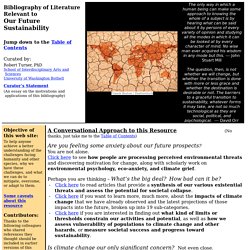
Some caveats about this resource Contributors: Thanks to the following colleagues who shared references they thought should be included in earlier versions of this resource. Jennifer Atkinson. Generation Anthropocene podcasts. 'A reckoning for our species': the philosopher prophet of the Anthropocene. A few years ago, Björk began corresponding with a philosopher whose books she admired.

“hi timothy,” her first message to him began. “i wanted to write this letter for a long time.” She was trying to give a name to her own singular genre, to label her work for posterity before the critics did. She asked him to help define the nature of her art – “not only to define it for me, but also for all my friends, and a generation actually.” It turned out the philosopher, Timothy Morton, was a fan of Björk. Over the past decade, Morton’s ideas have been spilling into the mainstream. Morton’s terminology is “slowly infecting all the humanities”, says his friend and fellow thinker Graham Harman. Part of what makes Morton popular are his attacks on settled ways of thinking. For the past 12,000 years, human beings lived in a geological epoch called the Holocene, known for its relatively stable, temperate climes.
Welcome to the Anthropocene. Generation Anthropocene: How humans have altered the planet for ever. In 2003 the Australian philosopher Glenn Albrecht coined the term solastalgia to mean a “form of psychic or existential distress caused by environmental change”.
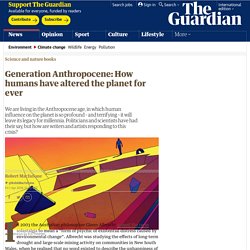
Albrecht was studying the effects of long-term drought and large-scale mining activity on communities in New South Wales, when he realised that no word existed to describe the unhappiness of people whose landscapes were being transformed about them by forces beyond their control. He proposed his new term to describe this distinctive kind of homesickness. Anthropocene. The Anthropocene Review: SAGE Journals. The trajectory of the Anthropocene: The Great Acceleration - Will Steffen, Wendy Broadgate, Lisa Deutsch, Owen Gaffney, Cornelia Ludwig, 2015.
Food in the Anthropocene: the EAT–<i>Lancet</i> Commission on healthy diets from sustainable food systems. Food systems have the potential to nurture human health and support environmental sustainability, however our current trajectories threaten both.
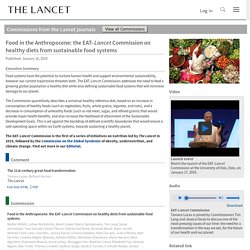
The EAT–Lancet Commission addresses the need to feed a growing global population a healthy diet while also defining sustainable food systems that will minimise damage to our planet. The Commission quantitively describes a universal healthy reference diet, based on an increase in consumption of healthy foods (such as vegetables, fruits, whole grains, legumes, and nuts), and a decrease in consumption of unhealthy foods (such as red meat, sugar, and refined grains) that would provide major health benefits, and also increase the likelihood of attainment of the Sustainable Development Goals.
Constructing the Anthropocene — Design Under Sky. [Anthropocene Construction Sketch. Image by Adam E. Anderson] We are focusing on the “Anthropogenic” layer of waste. The effort and energy of extraction, production, and disposal of fossil fuels, geologic commodities, and construction is awesome in scale, as well as the waste material created as a result.. The now closed Fresh Kills landfill in Staten Island New York is monumental, reaching over 150 ft. in some areas and containing some of the most noxious chemicals known to man.
We seek to understand the fear associated with waste that results in its displacement to marginal landscapes, often to the detriment of low-income inhabitants. PowerPoints Public Health in the Anthropocene. Anthropocene. Proposed geologic epoch, covering the present As of June 2019[update], neither the International Commission on Stratigraphy (ICS) nor the International Union of Geological Sciences (IUGS) have officially approved the term as a recognized subdivision of geologic time,[3][6][7] although the Anthropocene Working Group (AWG) of the Subcommission on Quaternary Stratigraphy (SQS) of the ICS voted in April 2016 to proceed towards a formal golden spike (GSSP) proposal to define the Anthropocene epoch in the Geologic time scale and presented the recommendation to the International Geological Congress in August 2016.[8] In May 2019, the 34 member AWG voted in favour of making a formal proposal to the ICS.[9][10] The most recent period of the Anthropocene has been referred to by several authors as the Great Acceleration during which the socioeconomic and earth system trends are increasing dramatically, especially after the Second World War.
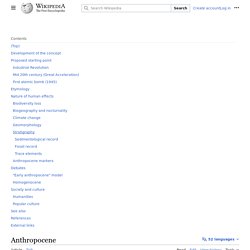
General[edit] Etymology[edit] Film – Anthropocene. Anthropocene: The Human Epoch. In December 2018, the Toronto International Film Festival named the film to its annual year-end Canada's Top Ten list.[4] In January 2019, it was announced as the winner of the Rogers Best Canadian Film Award from the Toronto Film Critics Association,[5] and of the Vancouver Film Critics Circle award for Best Canadian Documentary Film.[6] The film won two Canadian Screen Awards at the 7th Canadian Screen Awards in 2019, for Best Feature Length Documentary and Best Cinematography in a Documentary (de Pencier).

References[edit] External links[edit] Performing the Anthropocene. It’s a bright September morning in the early Anthropocene and we are in the back of a Maxi Taxi heading west towards the lowest point in Narrm, near where the Birrarung and the Maribyrnong flow together in the shadow of the Westgate Bridge. The Anthropocene Project. 1 Million Animal And Plant Species Are At Risk Of Extinction, U.N. Report Says : NPR. Symbiocene. Fighting the invisible enemy: What these images reveal about the coronavirus. Lyrebirds mimicking chainsaws: fact or lie? The lyrebird is considered one of Australia’s best-known birds — you might recognise them from our 10 cent coin — but do we really know them? Famed for their spectacular courtship display, you may have seen footage of lyrebirds mimicking human noises such as chainsaws and camera clicks.
But do lyrebirds in the wild really mimic chainsaws? Yes, if you search the internet; no, if you read the literature. Meet the lyrebirds There are two species of lyrebird in Australia. The lesser-known Albert’s lyrebird resides in a small, inhospitable area of southern Queensland rainforest from Tamborine Mountain to Lamington National Park. About the size of a pheasant, lyrebirds use their powerful legs and claws to rake leaf litter for worms, grubs, and insects.
Aside from their spectacular tail, lyrebirds are notable for their vocal abilities. The Limits to Growth. Limits to Growth was right. New research shows we're nearing collapse. The 1972 book Limits to Growth, which predicted our civilisation would probably collapse some time this century, has been criticised as doomsday fantasy since it was published. Is Global Collapse Imminent? Resources are being used up at a rapid rate, pollution is rising, industrial output and food per capita is rising. MSSI ResearchPaper 4 Turner 2014. Georgesteinmetz.